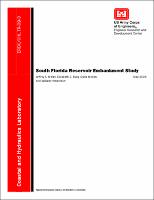Please use this identifier to cite or link to this item:
https://hdl.handle.net/11681/7666| Title: | South Florida Reservoir Embankment Study |
| Authors: | Melby, Jeffrey A. Burg, Elizabeth C. McVan, Darla C. Henderson, William G. |
| Keywords: | Embankments Reservoirs |
| Publisher: | Coastal and Hydraulics Laboratory (U.S.) Engineer Research and Development Center (U.S.) |
| Series/Report no.: | Technical Report (Coastal and Hydraulics Laboratory (U.S.)) ; no. ERDC/CHL TR-09-3 |
| Abstract: | As part of the Comprehensive Everglades Restoration Project (CERP), the Jacksonville District of the US Army Corps of Engineers is designing an impoundment embankment cross-section. The structure is intended to comprise the perimeter of a water supply basin. The conceptual cross-sections feature interior step and berm embankment faces to armor the containment levee, reduce wave overtopping to acceptable levels, and control reflected wave energy. The goal of the study was to develop engineering guidance for optimizing the structure cross-section to provide the minimum structure that met both wave overtopping and wave pressure design criteria. A small- scale physical model study of waves impacting and overtopping the embankment was conducted. A parallel effort was also completed using the COBRAS numerical model based on the Reynolds-averaged Navier Stokes (RANS) equations. The COBRAS model was shown to predict both wave overtopping and hydraulic pressures on the embankment well. An empirical equation was developed to predict wave overtopping as a function of structure configuration and wave and water level conditions. The study concluded that the stepped structure with no berm was optimal at reducing overtopping. The structure with continuous steps inhibits turtle egress from the basin. Therefore, guidance is provided for smooth slopes as well as for slopes employing separated blocks for overtopping reduction. The maximum pressures were shown to vary un-predictably with increasing berm width and depth. The maximum pressure was generally higher for the stepped structure without a berm than for the sections with berms. The highest pressures on the embankment appeared to be more a function of the details of the breaking wave interacting with the structure face than the structure geometry. |
| Description: | Technical Report |
| Gov't Doc #: | ERDC/CHL TR-09-3 |
| Rights: | Approved for public release; distribution is unlimited. |
| URI: | http://hdl.handle.net/11681/7666 |
| Appears in Collections: | Technical Report |
Files in This Item:
| File | Description | Size | Format | |
|---|---|---|---|---|
| CHL-TR-09-3.pdf | 686 kB | Adobe PDF |  View/Open |